New South Wales Ambulance
New South Wales Ambulance (abbreviated as NSW Ambulance), is an agency of NSW Health and the statutory provider of pre-hospital emergency care and ambulance services in the state of New South Wales, Australia.
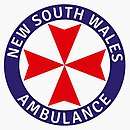 Seal | |
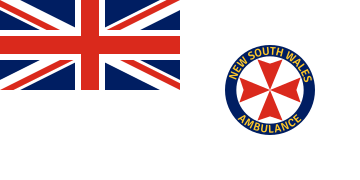 Flag | |
| Agency overview | |
|---|---|
| Formed | 1 April 1895 (Civil Ambulance and Transport Brigade) |
| Preceding agencies |
|
| Jurisdiction | New South Wales |
| Headquarters | Rozelle, New South Wales, Australia |
| Employees | 4,500+ |
| Minister responsible |
|
| Agency executive |
|
| Parent department | NSW Health |
| Key documents | |
| Website | www.ambulance.nsw.gov.au |
Established pursuant to the Ambulance Services Act, 1976 (NSW) and operating within the Health Services Act, 1997 (NSW), the service provides clinical care and health related transport services to over 7.9 million people in New South Wales (NSW), across an area of 801,600 square kilometres (309,500 sq mi).[1]
NSW Ambulance employs more than 4,500 staff (with over 90% involved in frontline operations such as Paramedics and Special Operations),[1] who operate over 1000 response vehicles from 226 locations across the state.[2] The service responds to around 1.1 million calls a year, with an average response time of 7.47 minutes to 1A emergencies (cardiac or respiratory arrests), against a target of 10 minutes.[3]
History
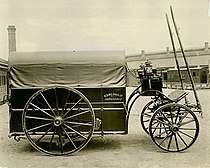
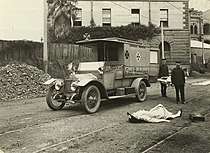
.jpg)
The first recognised ambulance service in New South Wales, known as the Civil Ambulance and Transport Brigade, commenced operations on April 1, 1895. Their first ambulance station was a borrowed police station in Railway Square, Sydney staffed by two permanent officers. At the time, patients were transported on hand-held stretchers and hand-litters.[4] As demand grew so did the service and they were soon transporting over 2,000 patients a year. In 1905, they became the Ambulance Transport Corps. In 1910, they opened their first station on the west side of the city, occupying the former parcels office at Summer Hill Railway Station.[4] In 1912, the first motorised ambulance entered service with the Corps, followed by two ambulance trams in 1915. The service then became the NSW Ambulance Transport Service Board in 1921, with further technological advances such as radios being installed in ambulances by the mid 1930s. By 1937, the Central District ambulance fleet had grown to 15 vehicles, with many others operating in districts across the state.[4] In 1958, the first fibreglass body ambulances entered service, marking a significant advancement in the design towards the modern ambulance.[5] In 1962, Station Officer Jim Smith (a former rigger at the Port Kembla Steelworks) became the first rescue trained ambulance officer in NSW. He received training from the existing Police Rescue Squad, and subsequently commenced operations on the service's new 'Q' (Rescue) Van.[6] In 1967, the Air Ambulance Service was established, operating a single Beechcraft Queen Air B80, which would later grow to a fleet of five aircraft over the next ten years.[7] In 1970, the service purchased 45 new Ford F100 Ambulances, which would become the face of the fleet for many years to come.[5] By the late 1970s and 1980s, Intensive Care Paramedics were introduced, allowing the service to bring unprecedented levels of pre-hospital care to patients.[4] In 1985, the Air Ambulance fleet received further upgrades with four new King Air B200C’s.[7]
As the importance of pre-hospital care skyrocketed in the service, the Special Casualty Access Team (SCAT) was formed in 1986.[4] This team of elite paramedics brought intensive care to patients in the most extreme of situations, ranging from cliff falls to building collapses. SCAT Paramedics were trained in a range of skills including climbing, winching, breathing apparatus, CBRNE, caving, canyoning, USAR, bushcraft, four wheel driving and wilderness survival.[8] A major step forward for the service came in 1991, when every ambulance in NSW was able to be equipped with a defibrillator.[9] In 2004, both immediate and long distance care were enhanced across NSW, with the purchase of new rapid response cars and new Air Ambulances (four King Air 200s).[4] The late 2000s saw vast increases to the services specialist capabilities, with the creation of the Medical Retrieval Unit,[10] the Special Operations Team[11] and the Extended Care Program,[11] making the service one of the most advanced providers of pre-hospital care in the world.
Paramedic
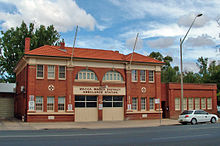
Primary Care Paramedics form the backbone of NSW Ambulance. They provide the bulk of frontline care, responding to all types of emergencies across the state. Paramedics are trained in a broad variety of medical skills, gained through either a NSW Ambulance diploma or a degree in Paramedicine.[13]
Intensive Care Paramedics (ICP) are highly skilled and experienced paramedics, who provide advanced intensive patient care. Their extensive experience and training allows them to conduct advanced medical procedures in the field and administer specialist drugs to seriously ill or injured patients.[13]
Extended Care Paramedics (ECP) are specialist paramedics who take a ‘GP’ type approach to non emergency incidents. Their role is to ease the workload of emergency ambulance crews by dealing with non emergency incidents using specialist training and techniques. These include prescribing medication, changing catheters, resetting dislocations etc. among many other skills.[14]
Critical Care Paramedics (CCP) are elite paramedics assigned to the Medical Retrieval Unit. As well as intensive care skills, they’re trained in Special Operations, allowing them to work in hostile environments such as building collapses, floods, caves, cliffs and remote bushland. They also have the ability to perform complex medical procedures and administer highly specialist drugs in the field to patients, under the authorisation of a Critical Care Doctor.[8][15][16]
Duty Operations Managers (DOM) are senior paramedic inspectors responsible for supervising clinical operations and managing crews on shift across each ambulance zone. They provide an experienced oversight at complex medical incidents, supporting paramedics with patient management and treatment. DOMs are generally qualified Intensive Care Paramedics, with a strong background of medical experience and leadership.[8]
Community First Responders (CFR) are part-time and volunteer members of other emergency services trained in advanced medical skills, who respond to medical emergencies in conjunction with Paramedics in remote areas of the state. There are 33 CFR units in total; 11 Fire and Rescue NSW, 11 NSW State Emergency Service and 12 Rural Fire Service, with each unit generally carrying their complement of medical equipment onboard their existing response vehicles such as fire engines.[17]
Response Priorities
NSW Ambulance prioritise cases into several priority levels based on the urgency of the case, which are categorised into:
- Priority 1 - Lights and Sirens Response
- 1A (Highest Priority) - Patient not breathing
- 1B (High Priority) - Patient unconscious
- 1C (Priority) - Urgent response required
- Priority 2 - Response without Lights and Sirens
- 2I - Immediate attendance required
- 2A - Attend within 30 minutes
- 2B - Attend within 60 minutes
- Priority 3 - Urgent Medical Transfer (Can be upgraded to Lights and Sirens depending on situation)
- The remainder of the priority levels are made up of various priority transfers.
As of early 2019, NSW Ambulance attended over two thirds of Priority 1 calls without 30 minutes.[18][19][20]
Special Operations
The Special Operations Team (SOT) are responsible for specialised ambulance operations across the state. SOT Paramedics are trained in a range of skills including abseiling, swiftwater rescue, breathing apparatus operations, structural collapse, tactical response, bushcraft and navigation. Their role is to bring intensive care to patients in any kind of hostile environment, including caves, canyons, cliffs, wilderness, bushland, collapses, bushfires, floods, shootings, hazardous materials incidents and many other kinds of complex entrapments.[8]
SOT operate response vehicles from seven stations in Metropolitan NSW including St Ives, Bankstown, Macquarie Fields, Caringbah, Point Clare, Wollongong and Northmead. They also operate a number of specialist support vehicles from their main base at Bankstown including 4WD Ambulances, Major Incident Support Units, a Multi Purpose Vehicle, a Forward Control Vehicle among others.[8][21] In some rural areas of Regional NSW, SOT are trained and equipped as primary rescue units, allowing them to extricate patients in addition to their medical role. They operate six rescues, based at Wagga Wagga, Singleton, Tamworth, Bomaderry, Cowra and Rutherford, with two spare vehicles located in Sydney. These rescues are equipped with a range of rescue tools including battery extrication equipment and rope rescue gear.[22]
Medical Retrieval
The Medical Retrieval Unit (MRU) (through the Rapid Launch Trauma Centre) are responsible for the coordination and response of NSW Ambulance’s Medical Retrieval Teams. Each Medical Team consists of a Doctor and a Critical Care Paramedic, who work together to bring the highest level of pre hospital clinical care to patients. Medical Teams can perform highly complex medical procedures in the field, ranging from rapid sequence intubation to roadside emergency surgeries. They operate from six bases across NSW, located at Bankstown, Albion Park, Orange, Belmont, Tamworth and Lismore, along with Hume in the Australia Capital Territory.[8][23]
Each Medical Team primarily operates an Augusta AW139 helicopter, with two aircraft attached to each base (with an additional spare at Bankstown). Each helicopter aircrew consists of a Pilot and a Crewman. The Teams also have access to a numerous specialist vehicles for road based responses, including 2WD and 4WD Ambulances. The helicopters are managed and maintained on a contract basis by TOLL (Southern Bases) and Westpac (Northern Bases).[24][25][26]
An additional medical team are based out of Westmead Hospital in Sydney, who are operated by the not for profit organisation Careflight. Their
Medical Teams consist of a NSW Ambulance Critical Care Paramedic, partnered with a Trauma Doctor from Westmead Hospital. They operate a Kawasaki BK-117 and respond in conjunction with NSW Ambulance’s other medical teams across the state.[27] The Air Ambulance Service also conduct long distance inter hospital patient transport, ensuring the continuation high level medical care between hospitals during transit. Based at Sydney Airport in Mascot, they operate five fixed wing aircraft, consisting of two Beechcraft Air King 350s and three Air King 200s. Each aircraft serves as a mobile hospital intensive care ward, catering for cases ranging from cardiac patients to births.[23]
Vehicles
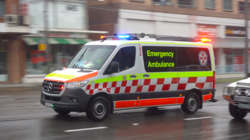 Mercedes Benz Sprinter
Mercedes Benz Sprinter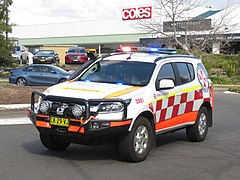 Holden Trailblazer Duty Operations Manager
Holden Trailblazer Duty Operations Manager Holden Colorado Special Operations Team Response Vehicle
Holden Colorado Special Operations Team Response Vehicle Hyundai iLoad Extended Care Ambulance
Hyundai iLoad Extended Care Ambulance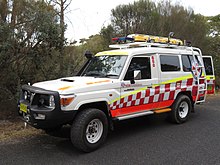 Toyota Land Cruiser 4WD Ambulance
Toyota Land Cruiser 4WD Ambulance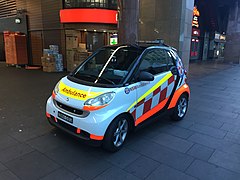 Smart response vehicle
Smart response vehicle Agusta Westland 139 Rescue Helicopter
Agusta Westland 139 Rescue Helicopter
Emergency Ambulances
The primary response vehicle of NSW Ambulance is the Mercedes-Benz Sprinter. Run by both General Duties and Intensive Care crews, Sprinters make up the large majority of the ambulance fleet across the state. A number of rural areas previously used Volkswagen Transporters, but these have now been replaced. Some rural stations also operate Toyota Landcruiser Troopcarriers which are configured for patient transport and are used to access patients in difficult and remote terrain. The Troopcarrier 4WD vehicles have an after market side access door on the left hand side for paramedic access into the treatment cabin.[8][28]
Multi Purpose Vehicles (MPVs)
MPVs are large custom built Mercedes Sprinters, which are equipped to deal with large complex bariatric patients. The rear patient transport area of the vehicle is significantly larger than a standard emergency ambulance, and is also equipped with specialist casualty loading and patient management gear, such as mechanical lifting equipment. As well as bariatric patients, the vehicles are also highly beneficial for patients undergoing hospital transfers who require specialist equipment such as life support machines to travel with them in the ambulance.[29]
Extended Care Paramedics (ECPs)
ECPs operate a fleet of Hyundai iLoads and Kia Sorento's which are fitted out with an extensive range of extended care equipment. Although the vehicles are unable to transport patients, this is actually
beneficial as the goal of the ECP program is to reduce patient transports to hospital and instead with their significant range of equipment, ECPs are able to treat patients at home.[14][28]
Paramedic Immediate Care Units (PICUs)
PICU’s provide rapid response to emergencies across Metropolitan NSW, utilising a range of Holden Captiva’s, and Kia Sorento’s. Staffed with a mix of GD and IC Paramedics, they’re able to provide immediate lifesaving care to patients in the busy areas of Sydney and Newcastle. NSW Ambulance also operate three Motorcycles, staffed by IC Paramedics, which are able to negotiate the tight and congested areas of Sydney’s inner city.[28]
Duty Operations Managers (DOMs)
DOM’s operate a range of response vehicles, predominantly SUV’s and Utilities, which allow them to respond rapidly to incidents and provide immediate on site expertise and oversight. Each vehicle carries an array of medical equipment similar to a PICU, allowing them to perform patient care when required (such as arriving on scene at an incident before an ambulance crew or assisting with multiple patients). The wide fleet of vehicles used by DOM’s includes Holden Captiva’s, Holden Colorado’s, Holden Trailblazer’s, Toyota Prado’s, Isuzu MUX’s, Isuzu D-Max’s and Kia Sorento’s.[28]
Over Snow Vehicles
Perisher Valley Ambulance Station operate a fleet of over snow vehicles, including a Hägglunds all terrain vehicle, a Kässbohrer Geländefahrzeug over snow vehicle, two Yamaha snowmobiles, a 4WD Quad Bike and trailer and a 4WD Mercedes Sprinter, which allow paramedics to access the alpine areas of the Snowy Mountains.[8]
Special Operations Team (SOT)
SOT operate custom built Holden Colorado’s as their primary response vehicles, which are fitted out with an equipment pod that allow them to carry specialist equipment such as cordage (rope) and breathing apparatus. Each vehicle is also fitted out with an array of medical equipment, allowing them to provide treatment to patients. SOT also operate Toyota Landcruisers for special operations work such as major incident deployments, which are often double crewed.[8]
They also operate a number of specialist support vehicles from the Special Operations HQ at Bankstown including;
– Forward Control Vehicle (Mercedes Sprinter fitted out as a mobile forward command post)
– Rescue Support Vehicle (Mercedes Sprinter fitted out with rescue and extrication gear, often used for training)
– Logistics Support Vehicle (Hino Truck used to carry bulk equipment and medical supplies)
– Major Incident Support Units (Two Mercedes Sprinters with custom bodies fitted out to carry major incident support equipment)
– SOT Multi Purpose Vehicle (Mercedes Sprinter MPV used for special operations) Each of the six SOT Rescue Units is also assigned a Hino Rescue Truck. Each Rescue is equipped with a wide array of rescue and extrication equipment such as forcible entry gear, battery cutting tools and rope rescue gear among other equipment. Each truck also carries a complement of medical equipment similar to SOT Response Vehicles. A seventh Hino Rescue is kept in Sydney as a spare, in addition to the Mercedes support vehicle.[8][28]
See also
References
- "About us". Ambulance Service of NSW. Government of New South Wales. 2011. Retrieved 20 November 2011.
- "NSW Ambulance – Ambulance Stations". NSW Ambulance. Retrieved 21 May 2019.
- "NSW Ambulance – Response Times". NSW Ambulance. Retrieved 21 May 2019.
- "NSW Ambulance History". NSW Ambulance. Retrieved 21 May 2019.
- "NSW Ambulance – 100 Years of Ambulance Vehicles" (PDF). NSW Ambulance. Retrieved 21 May 2019.
- "Jeep FC Rescue Truck". CJ3B. 31 January 2018. Retrieved 21 May 2019.
- "TBT: Looking back on NSW Air Ambulance's half a century of caring". Australian Aviation. 2018-08-02. Retrieved 2019-05-21.
- "NSW Ambulance – Emergency Operations". NSW Ambulance. Retrieved 21 May 2019.
- "Packer legacy to live on through charity". The Sydney Morning Herald. 2005-12-27. Retrieved 2019-05-21.
- Achterstraat, Peter (September 2010). "NSW Ambulance Helicopter Emergency Medical Service Contract" (PDF). NSW Ambulance. Retrieved 21 May 2019.
- "NSW Ambulance Year in Review 2009–2010" (PDF). NSW Ambulance. 2010. Retrieved 21 May 2019.
- WAGGA WAGGA - Opened December 2017 Rural Ambulance Infrastructure Reconfiguration
- "NSW Ambulance – Paramedics". NSW Ambulance. Retrieved 21 May 2019.
- "NSW Ambulance – Extended Care Fact Sheet" (PDF). NSW Ambulance. Retrieved 21 May 2019.
- "What is a SCAT Paramedic?". Retrieved 2020-02-27.
- "Meet our only female commando of medicine". www.dailytelegraph.com.au. 2014-11-19. Retrieved 2020-02-27.
- "NSW Ambulance – Volunteers". NSW Ambulance. Retrieved 21 May 2019.
- "Ambulance Service of NSW (NSW) - The RadioReference Wiki". wiki.radioreference.com. Retrieved 2020-03-06.
- Gladstone, Kate Aubusson, Nigel (2019-06-12). "The Sydney suburbs with the longest ambulance response times". The Sydney Morning Herald. Retrieved 2020-03-06.
- "Bureau of Health Information - Healthcare Quarterly Report" (PDF). June 2019.
- "NSW Ambulance Year in Review 2009/10" (PDF). NSW Ambulance. 2010. Retrieved 21 May 2019.
- Wallace, Natasha (2008-09-03). "Firies to take over some ambulance rescue units". The Sydney Morning Herald. Retrieved 2019-05-21.
- "NSW Ambulance – Aeromedical". NSW Ambulance. Archived from the original on 10 April 2013. Retrieved 21 May 2019.
- Pearce, Melanie (2014-12-19). "New operator for Orange based rescue chopper". ABC News. Retrieved 2019-05-21.
- "Toll Helicopters starts saving lives in southern NSW". Australian Aviation. 2017-01-13. Retrieved 2019-05-21.
- "Westpac Rescue Helicopter – Operations". Westpac Rescue Helicopter. 2016. Retrieved 21 May 2019.
- "Careflight – About Us". Careflight. 2019. Retrieved 21 May 2019.
- "NSW Ambulance – Vehicles". NSW Ambulance. Retrieved 21 May 2019.
- "New 'multi-purpose' ambulances helping transport morbidly obese patients weighing up to 300kg". amp.9news.com.au. Retrieved 2019-05-21.